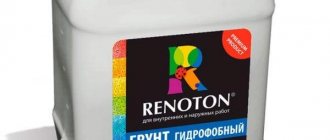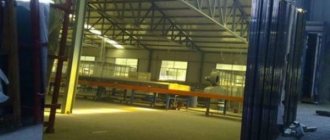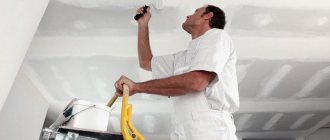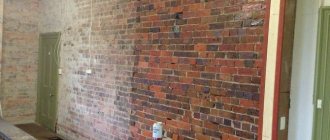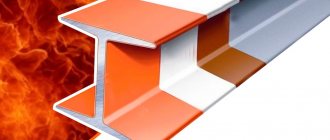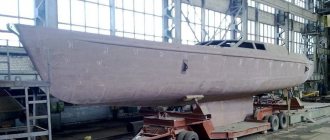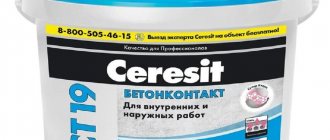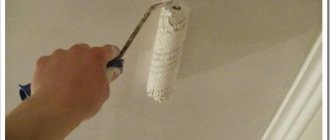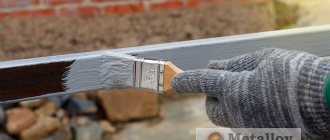Is it necessary to prime wood for varnish?
It is believed that varnish can protect wood from the negative effects of the environment. However, this composition partially solves this problem.
Wood must be primed in cases where the material is constantly in contact with water or is used in conditions of high humidity. In such situations, varnish is not able to prevent the development of mold or rotting.
However, not only such problems are solved by the primer.
Purpose and properties of soil
Treating wood with a primer has several purposes:
- Surface disinfection. The tree is susceptible to rotting. This process is accelerated in conditions of high humidity or against the background of the proliferation of pathogenic microflora such as fungus. A primer with antiseptic properties prevents the development of these processes and also repels insects.
- Surface strengthening. Wood has a porous structure, which is why the material becomes less strong over time. The primer penetrates deep into the surface, bonding the fibers together and thereby increasing the service life of the structure.
- Decreased absorption capacity. Wood absorbs moisture well, and the soil prevents this.
- Increased adhesion. Thanks to the primer, the surface acquires a rough structure, which increases the level of adhesion of the applied paint. This allows you to reduce the consumption of finishing material.
- To level the surface. The soil, as noted earlier, binds the fibers together. Due to this, the paint applied on top forms an even layer after drying.
- Preventing the formation of defects. Wood contains resins, tannins and other substances that seep out over time. Because of this, noticeable stains form on the surface. The primer layer prevents substances from escaping.
It is necessary to prime wood in the following cases:
- the material is used in the external environment;
- wood is located in rooms with high humidity;
- defects have been identified on the tree;
- wooden structures located indoors are in contact with external walls;
- the wood is subsequently painted or varnished.
It is recommended to prime all types of wood, regardless of the characteristics of the latter.
Pros and cons of applying a primer coat
Applying a primer layer under varnish has the following advantages:
- a layer is formed that protects against rot, mold, fungi and rodents;
- the service life of wooden structures increases;
- wood can be used outdoors and in conditions of high humidity;
- the consumption of paints and varnishes is reduced;
- the strength of the wooden structure increases.
See also
Classification of types of primers according to different criteria and how to choose the best one
The disadvantages of surface priming include the following:
- the cost of the work may ultimately exceed the costs incurred when painting without prior priming;
- finishing takes longer, since before varnishing the surface it is necessary to wait until the primer dries.
Expert opinion
Zakharova Irina Yurievna
Cleaning professional with 15 years of experience. Our best expert.
Ask a Question
Despite these disadvantages, priming wooden surfaces has become a mandatory procedure, which is carried out in almost all types of finishing work.
Primer varnishes
Deciding whether or not to use a primer is a very important decision.
The use of primer varnish is necessary in the following cases:
- to avoid getting water residue on the surface of the plank, which raises the wood fibers;
- to achieve the desired color tone of the wood surface, to prevent “burning” the plank;
- for isolating residues of special primers, oil impregnations and wax mastics;
- to improve the adhesion of parquet varnishes to the flooring surface;
- for the purpose of isolating natural oils of exotic wood species;
- to reduce the adhesive effect of parquet varnish in the side joints of the planks.
If the primer varnish layer is not applied in such cases, then when applying the main varnish layer, adhesion may be disrupted and the varnish film may rupture at the joints of the planks. Before applying primer varnishes, it is necessary to check whether they are compatible with the base varnish and the parquet floor. The possibility of using soil for heavily worn areas of the floor should be checked experimentally each time.
A solution of nitrocellulose or polyvinyl chloride can be used as a base for primer varnishes. Under the water-based varnish, apply a water-based primer, the binders of which are compatible.
Due to their thixotropic properties, primer varnishes make it possible to limit the penetration of parquet varnishes into the thickness of the wood. This allows you to reduce the consumption of parquet varnishes per square meter of area.
Drying of primer varnishes occurs mainly physically due to the evaporation of the solvent. The duration of drying to the state of technological curing is significantly less than that of parquet varnish and ranges from 15-20 minutes to 1-3 hours.
In addition to primers, there are glazing compounds (impregnating varnishes, stains). They are colorless and colored and are designed to protect parquet and other wooden surfaces from biological damage (rotting, mold, etc.) and atmospheric influences (temperature changes, high humidity). Colorless primers allow you to preserve the natural color of wood for a long time, and are also used to lighten colored compounds and pre-impregnate wooden surfaces before applying parquet varnish.
Professional parquet varnishes may or may not require primers. The need to use primers depends on many factors, which the parquet floorer must take into account. In the product data sheet, many varnish manufacturers indicate the types of primers that are compatible with their varnishes.
It is advisable that both the primer and the varnish are made by the same paint manufacturer. This is due to different degrees of cleaning of varnishes. Thus, the use of a domestic primer under Swedish or German varnish can lead to a deterioration in the transparency of the coating as a whole, which will affect the final perception of the varnish layer.
Application of primer varnishes
The primer must be applied to a well-cleaned surface, evenly distributed along the fibers. It is not recommended to apply primer varnishes to floor surfaces covered with parquet varnish.
Primer for parquet or parquet boards is a necessary component when laying floors. This is especially important when using exotic wood. The primer becomes the link between the varnish coating and the parquet. When using it, you can achieve brighter and more saturated shades of parquet boards.
Parquet primers are applied to natural wood flooring before layers of parquet varnish are applied. Primer varnishes fill wood pores and small cracks well, after which the varnish is applied to the prepared, flat surface. Primer varnishes are recommended to be used on exotic and oil-based woods before applying water-based varnishes. Parquet primers dry quickly, are easy to apply, provide a smooth surface and are easy to sand.
The primer plays a very important role when laying parquet boards. It fills all small cracks and pores with an even layer, reduces gaps and makes the material smooth. When using a primer, a hard layer is created on the surface of the wood material, which makes the parquet even more durable. Only with the help of a primer can you achieve impeccable smoothness and uniform structure of the material, so that the varnish applies evenly. Also, when using a primer material, varnish consumption is significantly reduced. High-quality material can protect the surface of the parquet from mold, rot and temperature changes, and it also prevents the appearance of dark spots on the parquet.
Selection of primer material
In order to choose the right primer composition, you first need to have complete information about the varnish that will be used to coat the package. A primer containing a solvent is suitable for a varnish that also contains a solvent or is made from polyurethane. For water-dispensed varnish, a water-based primer is required, and you need to use a colorless composition if it is necessary to lighten the parquet and the varnish will be colorless.
Which primer for parquet and parquet boards should I choose?
- Acrylic - diluted with water, which allows it to dry quickly; this composition has no odor.
- Alkyd is recognized as the best at the moment. When using it, it is possible to achieve an enhanced, more saturated color, and also creates a matte film on the surface. It dries within 10-16 hours.
- Shellac - serves as an insulator for wood; it is based on the milky juice of insects diluted with methyl alcohol.
The leader on the market is a primer for parquet from the German company; this is one of the oldest companies producing parquet chemicals. A few more brands that require attention are ICAR and ADESIV; these Italian companies have been demonstrating their superiority in the market for these products for several years now.
Nowadays, the primer water gel “LOBADUR WS TOP GEL” on a PU-acrylate base, intended for application between layers of varnish, is gaining popularity in the parquet paint and varnish market. This gel clogs small cracks up to 0.3 mm and coarse wood pores, thereby preventing the varnish from falling through, and the surface looks optically filled.
There are also domestic primer varnishes, but consumers should remember that the domestic industry produces them from cheaper raw materials, so these primers will be inferior to imported “big-name” analogues in terms of performance properties.
Next →
← To the beginning of the article
Which primer is suitable?
Due to the fact that different types of primer are applied under the varnish, when choosing this material the following circumstances must be taken into account:
- Application area. If priming of surfaces located on the street is carried out, then compositions for facade work that can withstand atmospheric influences are used.
- Climatic features. Some primer mixtures are intended for finishing wood, which is used in conditions of high temperature and low humidity. To paint surfaces in damp rooms, compositions with a hydrophobic effect are used.
- Drying duration. The duration of this process determines the time it takes to complete the repair work. Alkyd primer dries faster than others.
- The type of material that is applied on top. When processing wood, it is recommended to use transparent primers that emphasize the structure of the surface. However, white compounds are used under the paint.
It is also recommended to pay attention to the composition of the primer mixture. If the material contains harmful substances, finishing work should be carried out outdoors.
Varieties by composition
The types of varnish primers according to their composition are summarized in the table below.
| Type of mixture | Characteristics |
| Acrylic | The composition penetrates deeply into the structure of the wood, completely saturating the material. Acrylic primer is used for painting with any mixtures. This product is odorless, dries within 1-4 hours and is used for interior work. Water is used to change the viscosity of acrylic primer. |
| Silicone-acrylic | Silicone, which is part of the mixture, increases the hydrophobic properties of the soil. Thanks to this material, it is possible to process wood used in damp areas. A surface finished with such soil stops absorbing moisture. |
| Alkyd | Such mixtures are used when the surface is subsequently treated with alkyd dyes. Such compositions dry within 12-18 hours. Alkyd primer can also be applied to a painted surface. Mixtures containing colored pigments form a matte layer after drying. |
| Polyvinyl acetate | This type of soil dries within 30 minutes. To increase adhesion, it is recommended to apply a thin layer of PVA glue after treatment. |
| Polyurethane | This is the most expensive type of primer for varnish. In such mixtures, solvents in different concentrations are used. Also, the primer does not contain pigments. |
| Shellac | This mixture is used to level a wooden surface. Shellac primers close natural pores, thereby preventing resin from escaping. The mixture also creates an insulating layer, so the composition can be applied to raw materials. |
See also
Top 7 types of fabric paints and how to apply them at home
By properties and purpose
Primers used for varnish finishing are also divided into the following types:
- Antiseptic. Such mixtures contain components that prevent the formation of mold and mildew, prevent wood from rotting and repel insects and rodents.
- Strengthening. Such mixtures strengthen wooden structures, extending their service life. Such compositions are presented as deep penetration primers and increase the resistance of the treated surface to weathering.
- Hydrophobic. These primers are used for finishing wood used outdoors or in rooms with high humidity.
The type of primer is always indicated on the container with the mixture.
The nuances of priming wood
Today there are many methods for priming structures before varnishing. Often used:
- Liquid wax in cans.
- Wax dissolved in turpentine.
- An aqueous solution with crushed chalk, which has a certain color.
- Wood powder and PVA glue.
In turn, before purchasing a primer, you should pay attention to the following points:
- if you plan to varnish with a solvent-based varnish or with polyurethane, then the primer must also contain a solvent;
- if the varnish is water-based, then the primer should be water-based acrylic (alternatively, chalk).
Rating of the best brands
The presented rating is based on user reviews collected on the Internet. The primer grades indicated in the list are not suitable for all wood operating conditions.
Belinka Base
This soil provides protection against:
- rotting;
- mold formation;
- damage to the material by woodworms.
Such characteristics led to a high price: 5 liters of Belika Base cost more than 2.6 thousand rubles.
Biofa 3754
A universal mixture used for treating uneven surfaces and types of wood (mainly coniferous species), which absorb applied compounds well. This material is recommended for exterior and interior decoration. Biofa 3754 does not contain solvents, which allows the mixture to be used in conditions with poor ventilation. A 1-liter container of such primer costs about 1 thousand rubles.
Tikkurila Euro Primer
A primer, or deep penetration primer, of a Finnish brand is used for finishing external surfaces. The material contains components that give the mixture antibacterial and disinfecting properties. Despite these characteristics, 3 liters of this primer cost 400 rubles.
"Tex"
This brand produces primer mixtures intended for treating porous surfaces. Such compositions can be used for:
- paint and varnish coatings;
- wallpaper;
- decorative tiles.
Tex brand soils have the following features:
- suitable for treating surfaces in rooms with normal or high humidity;
- fireproof;
- do not emit an unpleasant odor;
- dry quickly;
- strengthen wood and other porous materials.
Tex brand primers penetrate deep into the wood structure, binding the fibers. Thanks to this effect, the indicated results are achieved.
The best manufacturers
In the selection process, price plays a decisive role, but not in the case of parquet primer: parquet boards are an expensive material, so it is better not to skimp on components that ensure long-lasting and flawless operation. List of the most popular manufacturers whose products are in deserved demand:
- Polifarb Debica is a Polish manufacturer that offers high-quality compounds for treating almost any wood. A distinctive feature is the increased adhesion of the base to the finishing coating.
- Bona. Plus - the coatings resist mechanical stress well, are quickly applied and improve the adhesion of the base to the varnish. In addition, primers can be used to renew parquet slats - the composition quickly eliminates unevenness.
- Osmo is a manufacturer of environmentally friendly primers that do not cause allergies. The compositions can be used in areas with high safety requirements.
- ADESIV is a manufacturer of a wide range of deep impregnation products, strengtheners, quick-drying primers and other compounds.
- LOBA. The best-known product is a water-based parquet primer suitable for all European wood species. There is an assortment of compositions for exotic, unstable varieties of wood.
- STAUF is a brand of products based on polyurethane, epoxy resins, and also water-based. The dispersion primer from this manufacturer dries in 45 minutes and is a universal product for any type of parquet.
Domestic manufacturers are not as good as foreign ones and often use not the highest quality raw materials in production.
Processing rules
Primers are applied in the same way as paint and varnish coatings. However, in this case it is necessary to take into account a number of nuances that have a direct impact on the quality of the dried layer.
Material consumption
The primer consumption is indicated on the packaging and depends on various factors: application conditions, type of surface to be treated and others. On average, when processing a square meter of surface, up to 80-120 milliliters of protective material are used.
Required Tools
The type of tools for priming wood is also selected based on the work conditions. To apply the material, you can use a sprayer, roller or brush. It is also recommended to purchase tools and devices for cleaning surfaces from defects.
See also
Technical characteristics and composition of the primer XC-059, application rules
Surface preparation
Before priming the wood surface you must:
- remove dust, dirt, small hair;
- putty on visible and minor defects;
- polish the structure.
If there are greasy stains on the surface, it is recommended to treat such areas with a soap solution. Old paint should also be removed before priming the wood.
Acrylic compounds should be used as putty, which, after drying, retain the same elasticity and do not crack if the size of the processed material changes.
Applying a layer
Despite the fact that primers are produced in ready-made form, it is recommended to carefully place the composition before application. After prolonged storage, sediment appears at the bottom of the container. You should work at temperatures from +5 to +30 degrees.
Over old paint
It is possible to prime wood over old paint if the type of previously applied material matches the protective mixture. But before starting work, it is recommended to remove loose pieces and treat the surface with sandpaper. This will increase the adhesion of the wood and speed up the finishing process.
If the shade of the old paint and varnish do not match, the surface must be primed in 2 layers. Further work can be carried out after the protective composition has completely dried. If the old paint differs in characteristics from the new one (for example, alkyd was previously used, but now oil is applied), then first the surface should be heated with a construction hairdryer. After this, you need to remove any remaining material, using a solvent if necessary.
If the soil does not contain substances that prevent the formation of mold, the wood should be treated with an antiseptic before applying the mixture.
On fresh wood
The primer can be immediately applied to fresh wood after preparing the surface. In this case, there is no need to carry out any other work.
Drying time and further work
The drying time depends on the type of primer and work conditions. The protective material gains strength within 0.5-18 hours. At temperatures above +25 degrees this process takes less time. After priming, the wood can be treated with varnish or other finishing materials.
Mistakes when priming parquet and wood
When priming wooden structures, the following mistakes are most often made:
- They use cheap soils whose characteristics do not meet operating conditions. In this case, the varnish will begin to crack early, and traces of mold and rot will appear on the wood.
- Supplements are added. Mixing soil with antiseptic and other substances leads to the material losing its original properties.
- Poor surface preparation. Because of this, the service life of the paintwork is reduced.
To avoid problems, it is recommended to select a primer for the specific varnish and operating conditions of the wood.
